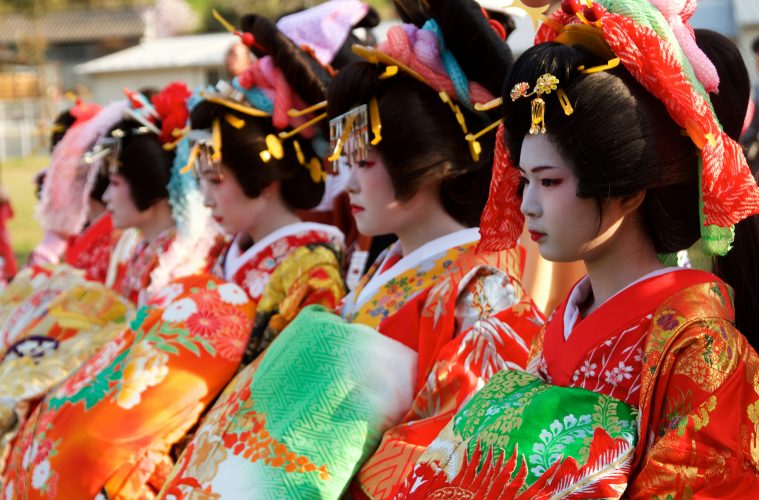The Geisha: A symbol of Japanese grace, beauty, and femininity. Artists and entertainers, the Geisha are synonymous with old-world Japan and have been entertaining travelers and locals for over four hundred years.
What makes a Geisha is a series of things that make someone elegant and these women have mastered them all. Geisha’s became very popular when a film titled, “Memoirs Of A Geisha” was released. It reviled a world of beauty, passion, pain and love. Although this movie brought a lot of controversy to the art itself, the tradition continues to thrive as a staple of true beauty in Japan. The women’s lives are extreemly private and they carry many secrets but Destination Luxury is sharing ten secrets of the art of the Geisha with you below.
10. LANGUAGE OF THE KIMONO
While kimonos are beautiful, silken, and artful works, they actually have their own subtle language. A Kimono sleeve pulled up enough to expose a wrist, for example, is supposed to be seen as sexy and seductive. A little skin goes a long way, it seems.
9. THE JOB DOESN’T ENTAIL “THAT”
Not so much a secret as a terrible misconception, a Geisha is neither a stripper nor hooker, despite how much imagery exists of such an idea. This seems to stem from the fact that some Geisha would be selected to be concubines, and not from any sort of real truth.
8. THE MAKEUP IS AN ART
While it seems obvious, the iconic Geisha makeup has multiple purposes. One is to make the performer anonymous among her other entertainers, in order to keep her mysterious and alluring. It’s just as important for them to not apply it to certain places, namely, the nape of the neck. As stated, a little skin goes a long way.
7. NO PHONES
Even as Geisha have entered modern times, they continue to live with rather traditional means. This means that no Geisha is allowed to communicate via telephone or computer. All communication is either done face to face or via letters.
6. CONTRACTUAL PURITY
And you thought Disney held the patent on chastity: A Geisha is not allowed to be in any sort of romantic relationship as long as she is a Geisha, and must retire after marriage. It seems to tie back to the idea that a Geisha is not to be “known,” from what we can tell.
5. IT’S NOT CHEAP FOR A REASON

A Geisha kimono costs anywhere in the ballpark of $30,000 to $80,000; A small fortune for anyone and even more so for entertainers. This isn’t even going into how expensive makeup, hair, training, and living conditions can be. It may seem like you’re paying a lot just for the company of a woman, but believe us, it’s far more than that.
4. TRAINING IS MANDATORY

While many people seem to believe the Geisha’s job is only to look pretty, that is far from the truth. A Geisha is expected to be a singer, a musician, a dancer, a conversationalist, a waitress… It’s about nine-hundred different jobs at once. As such, training begins for young Geisha (known as Meiko) at around 16 years of age, and they will not be considered full Geishas for at least four to six years.
3. INVITATION ONLY

In most tea houses in Kyoto, the original capital of Japan, many Geisha tea houses and restaurants have a code where a new guest needs to be introduced into such an environment by a well-established guest. This code known as ichi gen san o kotowari, or translated as “introduction only – no first time visitors.” Pretty direct, but a first-timer should still expect the best service available. It’d be rude not to.
2. THEY’RE SECRET KEEPERS

Mineko Iwasaki was of the most prominent and important Geishas of post-World War II Japan who caused a national stir when she retired at 29. She also started receiving death threats after it was revealed that she was interviewed for the 1997 best-seller Memoirs of a Geisha. While Iwasaki would eventually publish her own book and set the record straight, the fact remains a Geisha might absorb many secrets but she is expected to not share them. Ever.
1. THE FIRST GEISHA WERE MEN?!

A mind-blowing fact: The first Geisha were more or less seen as Jesters and were used for bouncing off ideas from generals and entertaining people. They were also all men. The transition from Taikomochi (the term used for male Geisha) to Geiko (what we know as Geisha) came around the late 1700s. Another cool fact is that there are still Taikomochi in this day and age: They’re just not very common.
What do you find interesting about the Geisha? Let us know in the comments below!












